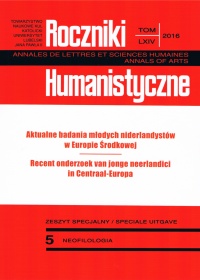The influences of valency of psych-verbs on the word order in the middle field
Abstract
This paper is a summary of my research on the influence of valency of Dutch psych-verbs on the word order of the nominal subject and nominal object in the middle field of the Dutch sentence. It’s been noted by some linguists that certain verbs allow for the subject to be placed behind the object in the middle field of the Dutch sentence, which means that they deviate from the tendency to place nominal subject before the nominal object. Most of the verbs described to behave in this manner are called psych-verbs or psychological verbs. These verbs refer to a situation in which an animate being can be subject to a change of their psychological state. Valency is defined as the ability of a verb to bind a number of elements in order to form a grammatically correct sentence. However, valency has to be seen not only from the syntactic, but also from the semantic point of view. In other words, I am not only interested in the number of elements a verb requires, but also in the semantic features of these elements such as animacy, affectedness etc. In my research I analyzed twenty psych-verbs to find out which aspects of valency can influence the word order of the nominal subject and nominal object in the middle field. The main results of the analysis are presented in this paper.
References
Allerton, David J. 1982. Valency and the English Verb. London & New York: Academic Press.
Bergen, Geertje van. 2011. Who’s first and what’s next. Animacy and word order variation in Dutch. Proefschrift. Radboud Universiteit Nijmegen. www.ru.nl/grammarandcognition/ students/vm/theses (31-08-2014)
Broekhuis, Hans. 1997. ‘Twee typen subject’. Nederlandse Taalkunde 2,1: 35–51.
Comrie, Bernard. 1981. Language Universals and Linguistic Typology. Oxford: Oxford University Press.
Fillmore, Charles J. 1971. ‘Some Problems for Case Grammar’. In R.J. O’Brien (red.), Report of the 22nd Annual Roundtable Meeting on Linguistics and Language Studies, 35–56. Washington, DC: Georgetown University Press.
Haeseryn, Walter, Kirsten Romijn, Guido Geerts et al. 1997. Algemene Nederlandse Spraakkunst. 2 delen. Groningen: Martinus Nijhoff & Deurne: Wolters Plantijn.
Kijonková, Jana. 2012. ‘Verbale valentie in het Nederlands en het Tsjechisch. Een eerste verkenning’. In Jelica Novaković-Lopušina et al. (red.): Lage Landen, Hoge Heuvels: Handelingen Regionaal Colloquium Neerlandicum, 317–326. Beograd: Arius.
Kijonková, Jana. 2015. ‘Valentie van psych-verbs en de gevolgen ervan voor de woordvolgorde: de casus overvallen en overkomen‘.Brünner Beiträge zur Germanistik und Nordistik 29, 2: 77–90.
Lamers, Monique J.A, & Helen de Hoop. 2011. ‘Animate object fronting in Dutch: a production study’. Unpublished manuscript. Radboud Universiteit Nijmegen.
Levin, Beth. 1993. English Verb Classes and Alternations. Chicago: University of Chicago.
Levin, Beth, & Jason Grafmiller. 2013. ‘Do you always fear what frightens you?’. In Tracy Holloway King & Valeria de Paiva (eds.). From quirky case to representing space: Papers in honor of Annie Zaenen. 21–32. Stanford: Center for the Study of Language and Information.
Pekelder, Jan. 2013. ‘Prédicats atypiques en néerlandais contemporain: le cas du type overvallen’. Syntaxe & Sémantique 14: 119–139.
Ruwet, Nicolas. 1994. ‘Être ou ne pas être un verbe de sentiment’. Langue française 103: 45–55.
Spencer, Nancy J. 1973. ‘Differences between linguists and nonlinguists in intuitions of grammaticality-acceptability’. Journal of Psycholinguistics Research 2: 83–98.
Svozilová, Naďa, Hana Prouzová & Anna Jirsová. 1997. Slovesa pro praxi — valenční slovník nejčastějších českých sloves. Praha: Academia.
Tesnière, Lucien. 1959. Éléments de syntaxe structurale. Paris: Klincksieck.
Vandeweghe, Willy. 2013. Grammatica van de Nederlandse zin. Antwerpen & Apeldoorn: Garant.
Copyright (c) 2016 Roczniki Humanistyczne

This work is licensed under a Creative Commons Attribution-NonCommercial-NoDerivatives 4.0 International License.





